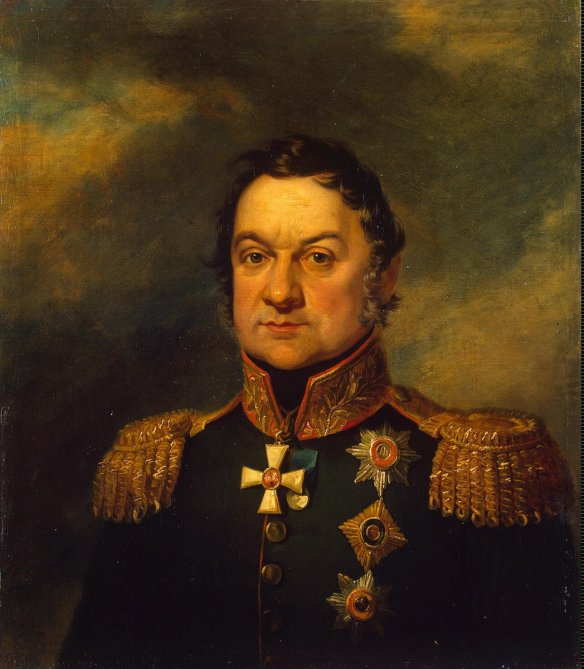
(1759-1816)
Dmitry Sergeyevich Dokhturov, a prominent Russian military commander, was born on 12 September 1759 to a Russian noble family from the Tula gubernia (province). He began service at the imperial court, becoming a page in 1771 and a kamer page in 1775. Dokhturov enlisted as a lieutenant in the Life Guard Preobrazhensky Regiment on 17 April 1781, becoming lieutenant captain in 1784 and captain in 1788. He participated in the Russo-Swedish War of 1788-1790, fighting at Rochensalmi (where he was wounded in the right shoulder), near the estuary of the Kumen River, at Hervanland (for which he received a golden sword), and Vyborg (where he was wounded). Dokhturov became a colonel and commander of the Yeletsk Infantry Regiment on 12 January 1795. Two years later, he rose to major general and chef of the Sofia Musketeer Regiment on 13 November 1797. Between 11 November 1798 and 3 August 1800, this unit was named Dokhturov’s Musketeer Regiment. Dokhturov was promoted to lieutenant general on 5 November 1799.
After brief retirement from July to November 1800, Dokhturov became chef of the Olonetsk Musketeer Regiment on 11 August 1801 and chef of the Moscow Musketeer Regiment and infantry inspector of the Kiev Inspection on 7 February 1803. During the 1805 campaign he commanded one of the columns in the Russian army, distinguishing himself at Krems (Dürnstein, for which he received the Order of St. George [3rd class], on 24 January 1806) and Austerlitz (for which he received the Order of St. Vladimir [2nd class]). In 1806-1807, he led the 7th Division in Poland, fighting at Golymin (for which he received the Order of St. Anna [1st class]), Eylau (where he was wounded in the right leg and earned a golden sword with diamonds), Lomitten (for which he received the Prussian Order of the Red Eagle [1st class]), Heilsberg (for which he received the Order of St. Alexander of Neva), and Friedland. In 1809 he took part in the operations against the Austrian army in Galicia, for which he received the Order of St. Catherine. Promoted to general of infantry on 1 May 1810, he took command of Fourth Corps that November and of Sixth Corps of the 1st Western Army in early 1812.
During the 1812 campaign Dokhturov defended Smolensk, for which he later received 25,000 rubles, and distinguished himself at Borodino, where he took command of the 2nd Western Army after Prince Peter Bagration was injured. For his actions in this battle Dokhturov was decorated with the diamond signs of the Order of St. Alexander of Neva. At the council of war at Fili he recommended engaging Napoleon in the vicinity of Moscow. In October and November he fought at Aristovo, Maloyaroslavets (for which he received the Order of St. George [2nd class]) and Krasnyi. In 1813 he commanded the right flank of the (Russian) Army of Poland, fighting at Berggieshubel, Dohna, Dresden, Leipzig (for which he received the Order of St. Vladimir [1st class]), Magdeburg, and Hamburg, where he remained until the end of the war. In late 1814 Dokhturov took a furlough to recuperate and nominally commanded Third Corps. During the Hundred Days, he returned to the army, commanding the right flank of the Russian army. Returning to Russia, he took a discharge because of poor health on 13 January 1816 and died on 26 November of the same year in Moscow.
References and further reading Dokhturov, D. S. 1874. “Pisma D. S. Dokhturova k ego supruge” [D. S. Dokhturov’s Letters to His Wife]. Russkii arkhiv 12. Mikaberidze, Alexander. 2005. The Russian Officer Corps in the Revolutionary and Napoleonic Wars, 1792-1815. Staplehurst, UK: Spellmount. Romanov, D. 1979. Polkovodets D. S. Dokhturov [Commander D. S. Dokhturov]. Tula: N. p.